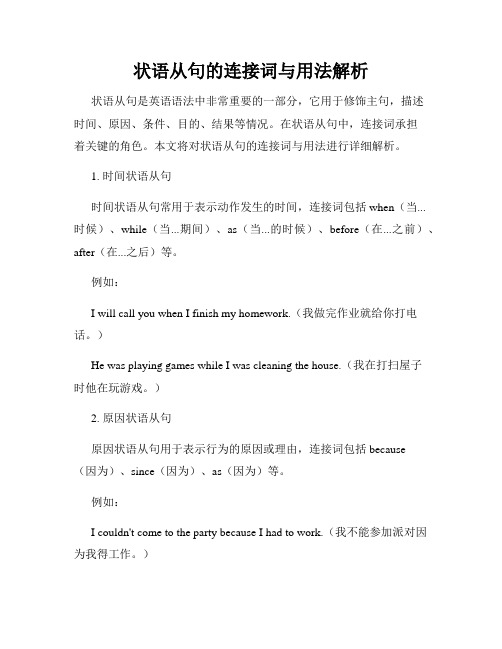状语从句类型及相似连词的用法区别
英语八类状语从句的用法归纳

英语八类状语从句的用法归纳-CAL-FENGHAI.-(YICAI)-Company One1英语八类状语从句的用法归纳一、概说状语从句即指在主从复合句用作状语的从句。
按照其意义,状语从句可分为时间状语从句、地点状语从句、原因状语从句、目的状语从句、结果状语从句、条件状语从句、让步状语从句等。
状语从句是高中英语学习中的一个语法重点,也是历年高考重点考查的内容之一。
学习状语从句主要应注意引导状语从句的从属连词的用法与区别,以及从属连词在一定的语言环境中的意义与用法。
二、时间状语从句1.引导时间状语从句的从属连词很多,常见的有before, after, when, while, as, since, till, until, as soon as 等。
2.表示“当…时候”的 while, when, as 的用法区别是:while从句中的谓语动词必须是延续性动词;表示带有规律性的“每当”或当主、从句谓语动词的动作发生有先后时,只能用 when;当表示“一边…一边…”或“随着”时,只能用 as。
另外,用于此义的 as 所引导的时间状语从句谓语只能是动作动词,不能是状态动词。
如下面一道高考题的答案是 B 而不能是A:“I’m going to the post office.” “_____ you’re there, can you get me some stamps”A. AsB. WhileC. BecauseD. If3. until 在肯定句中通常只连用延续性动词,表示相应动作结束的时间;在否定句中通常连用非延续性动词,表示相应动作开始的时间,意为“直到…才”。
如:He waited until she was about to leave. 他等着一直到她准备离开。
I did not begin to work till he had gone. 他走了后我才开始工作。
4.表示“一…就”除用 as soon as 外,还可用 the minute, the second, the instant, immediately, directly, instantly, no sooner…than, hardly…when等。
状语从句的连接词与用法解析

状语从句的连接词与用法解析状语从句是英语语法中非常重要的一部分,它用于修饰主句,描述时间、原因、条件、目的、结果等情况。
在状语从句中,连接词承担着关键的角色。
本文将对状语从句的连接词与用法进行详细解析。
1. 时间状语从句时间状语从句常用于表示动作发生的时间,连接词包括when(当...时候)、while(当...期间)、as(当...的时候)、before(在...之前)、after(在...之后)等。
例如:I will call you when I finish my homework.(我做完作业就给你打电话。
)He was playing games while I was cleaning the house.(我在打扫屋子时他在玩游戏。
)2. 原因状语从句原因状语从句用于表示行为的原因或理由,连接词包括because(因为)、since(因为)、as(因为)等。
例如:I couldn't come to the party because I had to work.(我不能参加派对因为我得工作。
)Since it's raining outside, we should stay indoors.(因为外面下雨,我们应该呆在室内。
)3. 条件状语从句条件状语从句用于表示某种条件下会发生的情况,连接词包括if (如果)、unless(除非)、provided that(倘若)、as long as(只要)等。
例如:If you study hard, you will pass the exam.(如果你努力学习,你会通过考试。
)I won't go swimming unless it stops raining.(除非雨停,否则我不会去游泳。
)4. 目的状语从句目的状语从句用于表示达到某种目的或意图的行动,连接词包括so that(以便)、in order that(为了)、lest(以免)等。
高中易考知识点状语从句的种类和用法

高中易考知识点状语从句的种类和用法状语从句是汉语中一个重要的语法结构,它能够在句子中作为修饰成分,用来描述动作或状态的情况。
在高中的语文考试中,状语从句是一个常见的知识点。
本文将介绍高中易考的知识点——状语从句的种类和用法。
一、状语从句的概念与基本特点:状语从句是指在复合句中做状语的从句,它可以用来修饰动词、形容词、副词或整个句子。
状语从句通常由连词引导,与主句之间有一定的逻辑关系。
二、状语从句的种类:1. 时间状语从句:时间状语从句表示动作发生的时间,在句子中可以作时间状语,修饰主句的谓语动词。
常用的引导词有when, as, while, before, after, since 等。
例如:- I will call you when I arrive home.(当我到家的时候,我会给你打电话。
)- He became a teacher after he graduated from university.(他大学毕业后成为了一名教师。
)2. 地点状语从句:地点状语从句描述动作的地点,在句子中作地点状语,修饰主句的谓语动词。
常用的引导词有wherever, wherever, anywhere等。
例如:- She will follow you wherever you go.(无论你去哪里,她都会跟随你。
)- I can find happiness anywhere I am.(无论我在哪里,我都能找到快乐。
)3. 原因状语从句:原因状语从句描述动作的原因,在句子中作原因状语,修饰主句的谓语动词。
常用的引导词有because, since, as, for等。
例如:- I stayed at home because it was raining heavily.(因为下大雨,所以我呆在了家里。
)- Since you are tired, you should rest.(既然你累了,你应该休息一下。
状语从句分类及常用连词

状语从句分类及常用连词一、状语从句分类及常用连词:类别连词地点状语从句where,wherever时间状语从句when, whenever, while, as, before, after, since, till, once, assoon as,etc.原因状语从句because, since, as, for, now that, etc.目的状语从句in order that, so that, that, etc.结果状语从句so…that, so that, such…that, that, etc.条件状语从句if, unless, as(so)long as, etc.让步状语从句though, although, even if, even though, however, whatever, as,etc.比较状语从句as…as, so…as, than, etc.方式状语从句as, as if, as though, etc.二、各种状语从句的连词的用法区别1 地点状语从句地点状语从句通常由where, wherever 引导。
Where I live there are plenty of trees. 我住的地方树很多。
Wherever I am I will be thinking of you. 不管我在哪里我都会想到你。
2 方式状语从句方式状语从句通常由as, (just) as…so…, as if, as though引导。
1)as, (just) as…so…引导的方式状语从句通常位于主句后,但在(just)as…so…结构中位于句首,这时as从句带有比喻的含义,意思是"正如…","就像",多用于正式文体,例如:Always do to the others as you would be done by.你希望人家怎样待你,你就要怎样待人。
状语从句的种类与用法总结

状语从句的种类与用法总结状语从句是在复合句中,作为主句中的一个成分,用来修饰或限制主句的动词、形容词、副词等成分。
状语从句分为时间状语从句、原因状语从句、条件状语从句、目的状语从句、结果状语从句、让步状语从句等几种类型。
下面将对这些状语从句的特点和用法进行总结。
1. 时间状语从句时间状语从句用来表示动作发生的时间,可以分为过去、现在和将来几个方面。
常见的引导词有when, while, as, before, after, since, until 等。
例如:- I will go to bed after I finish my homework.(当我完成作业之后,我会去睡觉。
)- She always looks happy when she sees her friends.(当她见到她的朋友时,她总是看起来很开心。
)2. 原因状语从句原因状语从句用来表示动作的原因,常见的引导词有because, since, as等。
例如:- He didn't attend the meeting because he was sick.(因为他生病了,所以他没有参加会议。
)- Since it is raining outside, we should bring an umbrella.(因为外面在下雨,所以我们应该带把伞。
)3. 条件状语从句条件状语从句用来表示某种条件下会发生的情况,常见的引导词有if, unless, provided that等。
例如:- If it rains tomorrow, we will stay at home.(如果明天下雨,我们会呆在家里。
)- You can go out unless it is too hot.(除非天气太热,你可以出去。
)4. 目的状语从句目的状语从句用来表示主句的动作是为了实现从句中的目的,常见的引导词有so that, in order that等。
状语从句的引导词及其区别

状语从句的引导词及其区别状语从句在句中作状语,修饰主句中的动词、形容词和副词等。
按其作用和意义可分为时间、原因、目的、结果、条件、让步、方式、比较,地点九种。
下面对这九种从句的要点加以总结。
一、各类状语从句的引导词及易混词的区别。
1. 时间状语从句1) 引导词(1)表示“当……时候”:when, while, as, wheneverWhen I went into the room, he was at work. 当我进屋时,他在工作。
While it was raining, they went out. 正在下着雨时,他们出去了。
Whenever he comes, he brings a friend. 他每次来都带个朋友。
(2)表示“一……就……”:as soon as, the moment/minute/instant, immediately/directly/instantly , hardly/scarcely…when, no sooner…than I’ll tell you the news the moment you come.你一来我就告诉你那个消息。
The machine will start instantly you press the button. 你一按按钮机器就会开动。
Hardly/Scarcely had I got to the cinema when the film began. 我一到电影院,电影就开始了。
I had no sooner reached home than it began to rain.我一到家天就下起了雨。
(3)其它:after, before, since, until, by the time,each time, next timeThe boy went to bed after he finished my homework. 那男孩做完家庭作业之后才睡觉。
初中英语知识点归纳状语从句的分类和用法
初中英语知识点归纳状语从句的分类和用法状语从句是英语语法中重要的一部分,它用来修饰主句的动作或描述情况的,在句子中起着状语的作用。
状语从句分为时间状语从句、条件状语从句、原因状语从句、目的状语从句、结果状语从句、方式状语从句和比较状语从句等。
下面将对初中英语中常见的状语从句分类和用法进行归纳。
一、时间状语从句时间状语从句用来表示动作或事件发生的时间,包括连词when (当...时候),while (在...时候),before (在...之前),after (在...之后),as (当),since (自从),until (直到)等。
时间状语从句一般放在主句之前或者之后。
例如:- When I was young, I used to play soccer with my friends. (当我年轻的时候,我常常和朋友们踢足球。
)- After she finished her homework, she went to bed. (她完成作业之后,去睡觉了。
)二、条件状语从句条件状语从句用来表示主句动作的条件或前提,包括连词if (如果),unless (除非),in case (以防),as long as (只要),provided/providing (只要)等。
条件状语从句一般放在主句之前。
例如:- If it rains tomorrow, we will stay at home. (如果明天下雨,我们就在家呆着。
)- Unless you work hard, you won't pass the exam. (除非你努力学习,否则你就不能通过考试。
)三、原因状语从句原因状语从句用来表示主句动作或情况的原因,包括连词because (因为),as (因为),since (因为),for (因为),now that (既然)等。
原因状语从句一般放在主句之前。
例如:- Because it was raining, we stayed at home. (因为下雨,我们呆在家里。
状语从句与表语从句的比较与状语从句与同位语从句的区别
状语从句与表语从句的比较与状语从句与同位语从句的区别状语从句和表语从句是复合句中常见的两种从句类型。
虽然它们在语法上都属于从属从句,但是它们在句子结构和语义功能上有着显著的区别。
另外,状语从句还有一个与同位语从句的区别。
本文将会对状语从句和表语从句进行比较,并探讨状语从句与同位语从句的区别。
一、状语从句与表语从句的比较1. 句子结构状语从句是复合句的一部分,通常由一个连词引导,而表语从句则是一个完整的句子,可以独立存在。
例句:- 状语从句:As I was walking to the store, I saw a friend of mine.- 表语从句:The fact that he failed the exam surprised everyone.2. 语义功能状语从句用来修饰主句的动作或者状态,起到说明、原因、条件、方式、时间等作用。
而表语从句则用来作主语或者宾语的补充,用来对主语或者宾语进行说明、定义、描述等。
例句:- 状语从句表示原因:Because it was raining, we decided to stay at home.- 表语从句作主语补充:That he is a genius is beyond doubt.二、状语从句与同位语从句的区别1. 句子结构状语从句和同位语从句在结构上没有明显的区别,都是由从属连词引导,但它们在句子中的位置和语义功能上有所差异。
2. 功能区别状语从句用来修饰或者说明主句中的动作或状态,起到状语的作用。
而同位语从句则用来对主句中的名词或者代词进行解释、补充或者说明。
例句:- 状语从句:He went to bed early because he had an important meeting the next day.- 同位语从句:The fact that he passed the exam made his parents proud.总结:状语从句和表语从句的区别在于句子结构和语义功能方面,前者是复合句的一部分,用来修饰主句的动作或状态;而后者则是一个完整的句子,用来作主语或者宾语的补充。
状语从句的分类和用法
状语从句的分类和用法状语从句是指在复合句中充当状语的从句,用来修饰主句中的动作或描述情况。
状语从句的使用能够丰富句子结构,使语言表达更加准确和生动。
本文将介绍状语从句的分类和用法。
一、状语从句的分类根据状语从句与主句之间的关系不同,状语从句可以分为时间状语从句、条件状语从句、原因状语从句、结果状语从句和让步状语从句等几种。
1. 时间状语从句时间状语从句用来表示动作发生的时间或频率,常见的引导词有when(当...时候)、while(当...的时候)、before(在...之前)、after (在...之后)等等。
例如:He called me when he arrived at the station.(他到达车站的时候给我打电话。
)2. 条件状语从句条件状语从句用来表示发生某种条件时的结果,常见的引导词有if (如果)、unless(除非)、in case(以防)、as long as(只要)等等。
例如:If it rains tomorrow, we will stay at home.(如果明天下雨,我们会呆在家里。
)3. 原因状语从句原因状语从句用来表示某个行为或情况的原因,常见的引导词有because(因为)、since(因为)、as(由于)、for(因为)等等。
例如:He couldn't come to the party because he was sick.(他因为生病不能来参加派对。
)4. 结果状语从句结果状语从句用来表示某个行为或情况的结果,常见的引导词有so...that(如此...以至于)、such...that(如此...以至于)、so that(以便)、such that(以便)等等。
例如:She studied hard so that she could pass the exam.(她努力学习以便能够通过考试。
)5. 让步状语从句让步状语从句用来表示与主句相对立的情况,常见的引导词有although(虽然)、though(虽然)、even though(即使)、while(尽管)等等。
连词与状语从句的区分
连词与状语从句的区分在学习语法的过程中,我们经常会遇到连词和状语从句这两个概念。
虽然它们都是语法中的重要要素,但是它们在功能和结构上有着明显的区别。
本文将探讨连词和状语从句的区分,并且通过一些例子来加深我们对这两个概念的理解。
首先,我们来看连词。
连词是一种连接词组、短语或句子的词语,用于建立句子之间的关系。
连词可以分为并列连词、从属连词和对等连词。
并列连词用于连接并列的词、短语或句子,常见的有"和"、"或"、"但是"等。
例如:"我喜欢吃水果和蔬菜",这里的"和"就是一个并列连词,将"吃水果"和"吃蔬菜"这两个动作连接起来,表示它们是同等重要的。
然后,我们来看状语从句。
状语从句是一个从句,用来修饰主句中的动作或状态,起到状语的作用。
状语从句常常由从属连词引导,常见的从属连词有"因为"、"如果"、"尽管"等。
例如:"因为下雨,所以我没有去公园",这里的"因为下雨"就是一个状语从句,它修饰主句中的"我没有去公园",表示原因。
那么如何区分连词和状语从句呢?首先,我们可以通过句子的结构来判断。
如果一个词或短语连接了两个句子,并且表示它们之间的关系,那么它很可能是一个连词。
而如果一个从句修饰了主句中的动作或状态,起到状语的作用,那么它就是一个状语从句。
其次,我们可以通过句意来判断。
连词通常用于表示并列关系或转折关系,它们的作用是将两个句子连接起来,使句子更加连贯。
而状语从句通常用于表示原因、条件、目的、结果等,它们的作用是对主句中的动作或状态进行解释或补充。
接下来,让我们通过一些例子来加深对连词和状语从句的理解。
例如:"我喜欢吃水果和蔬菜,因为它们对身体健康有益"。
- 1、下载文档前请自行甄别文档内容的完整性,平台不提供额外的编辑、内容补充、找答案等附加服务。
- 2、"仅部分预览"的文档,不可在线预览部分如存在完整性等问题,可反馈申请退款(可完整预览的文档不适用该条件!)。
- 3、如文档侵犯您的权益,请联系客服反馈,我们会尽快为您处理(人工客服工作时间:9:00-18:30)。
一、状语从句分类及常用连词:
类别连词
状语从句when, whenever, while, as, before, after, since, till, once, as soon as,etc.
状语从句where,wherever
状语从句because, since, as, for, now that, etc.
状语从句so…that, so that, such…that, that, etc.
状语从句in order that, so that, that, etc.
状语从句if, unless, as(so)long as, etc.
状语从句though, although, even if, even though, however, whatever, as,etc.
状语从句as…as, so…as, than, etc.
状语从句as, as if, as though, etc.
二、相似连词的用法区别
1.when, while, as,
while表时间,从句需用延续性动词,切不可用瞬间动词。
when表时间,从句既可以用延续性动词,又可以用瞬间动词。
as表时间,与when相似,但侧重强调主从句动作同点或同段进行。
when, while后可以接分词短语。
2.because, as, since, for
语气位置意义
because最强前或后“原因”;表客观因果关系;回答“”as较强前“由于”;把众人所知的事实当作理由since较弱前“既然”;就对方陈述的事实作为理由for最弱后“理由”;对某一事实进行推断的理由
注:上面所说的“前”,指从句在主句之前;“后”,指从句在主句之后。
3.so that, so…that, such…that
so that“以便”、“结果”表目的和结果。
注意:在从句中有情态动词表目的。
无情态动词表结果。
so…that “如此的…以致于”表结果。
该结构常见于:
1.so+形/副+that
2.so+形+a(an)+单数名词+that
3.so+manymuch+复数名词(不可数名词)+that
such…that“如此的…以致于”表结果。
该结构常见于:
1.such+a(an)+形+名词+that
2.such+形+复数名词/不可数名词+that
4.though, although, as,
though, although 在句首表“尽管”两者都可以用。
但句后不能再用but 。
下列情况只能用though :
▲ as though (=as if); even if (=even though)
▲ 在句末表示“然而”
as 表示“尽管”,从句的表语、状语等成分要倒装。
5.whatever, however,wherever, whenever
它们是what, how, where, when 的强势语气。
分别等于:
no matter what, no matter how
no matter where, no matter when
状语从句种类一卡通。
